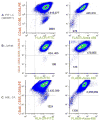A quantitative analysis of genomic instability in lymphoid and plasma cell neoplasms based on the PIG-A gene
- PMID: 20060400
- PMCID: PMC2834866
- DOI: 10.1016/j.mrfmmm.2009.11.012
A quantitative analysis of genomic instability in lymphoid and plasma cell neoplasms based on the PIG-A gene
Abstract
It has been proposed that hypermutability is necessary to account for the high frequency of mutations in cancer. However, historically, the mutation rate (mu) has been difficult to measure directly, and increased cell turnover or selection could provide an alternative explanation. We recently developed an assay for mu using PIG-A as a sentinel gene and estimated that its average value is 10.6 x 10(-7) mutations per cell division in B-lymphoblastoid cell lines (BLCLs) from normal donors. Here we have measured mu in human malignancies and found that it was elevated in cell lines derived from T cell acute lymphoblastic leukemia, mantle cell lymphoma, follicular lymphoma in transformed phase, and 2 plasma cell neoplasms. In contrast, mu was much lower in a marginal zone lymphoma cell line and 5 other plasma cell neoplasms. The highest mu value that we measured, 3286 x 10(-7), is 2 orders of magnitude above the range we have observed in non-malignant human cells. We conclude that the type of genomic instability detected in this assay is a common but not universal feature of hematologic malignancies.
Copyright 2010 Elsevier B.V. All rights reserved.
Conflict of interest statement
There are no conflicts of interest to report.
Figures




Similar articles
-
The rate of spontaneous mutations in human myeloid cells.Mutat Res. 2013 Sep;749(1-2):49-57. doi: 10.1016/j.mrfmmm.2013.05.004. Epub 2013 Jun 6. Mutat Res. 2013. PMID: 23748046 Free PMC article.
-
A quantitative measurement of the human somatic mutation rate.Cancer Res. 2005 Sep 15;65(18):8111-7. doi: 10.1158/0008-5472.CAN-04-1198. Cancer Res. 2005. PMID: 16166284
-
[Immunoglobulin heavy chain gene rearrangement study in difficult cases of B-cell lymphoproliferative disorder].Zhonghua Bing Li Xue Za Zhi. 2010 May;39(5):296-301. Zhonghua Bing Li Xue Za Zhi. 2010. PMID: 20654151 Chinese.
-
Ataxia telangiectasia gene mutations in leukaemia and lymphoma.J Clin Pathol. 2001 Jul;54(7):512-6. doi: 10.1136/jcp.54.7.512. J Clin Pathol. 2001. PMID: 11429421 Free PMC article. Review.
-
Review of alterations of the cyclin-dependent kinase inhibitor INK4 family genes p15, p16, p18 and p19 in human leukemia-lymphoma cells.Leukemia. 1998 Jun;12(6):845-59. doi: 10.1038/sj.leu.2401043. Leukemia. 1998. PMID: 9639410 Review.
Cited by
-
The rate of spontaneous mutations in human myeloid cells.Mutat Res. 2013 Sep;749(1-2):49-57. doi: 10.1016/j.mrfmmm.2013.05.004. Epub 2013 Jun 6. Mutat Res. 2013. PMID: 23748046 Free PMC article.
-
Leukemic blasts with the paroxysmal nocturnal hemoglobinuria phenotype in children with acute lymphoblastic leukemia.Am J Pathol. 2012 Nov;181(5):1862-9. doi: 10.1016/j.ajpath.2012.07.025. Epub 2012 Aug 30. Am J Pathol. 2012. PMID: 22940070 Free PMC article.
-
Both PIGA and PIGL mutations cause GPI-a deficient isolates in the Tk6 cell line.Environ Mol Mutagen. 2015 Oct;56(8):663-73. doi: 10.1002/em.21953. Epub 2015 May 13. Environ Mol Mutagen. 2015. PMID: 25970100 Free PMC article.
-
Do mutator mutations fuel tumorigenesis?Cancer Metastasis Rev. 2013 Dec;32(3-4):353-61. doi: 10.1007/s10555-013-9426-8. Cancer Metastasis Rev. 2013. PMID: 23592419 Free PMC article. Review.
-
PIGN gene expression aberration is associated with genomic instability and leukemic progression in acute myeloid leukemia with myelodysplastic features.Oncotarget. 2017 May 2;8(18):29887-29905. doi: 10.18632/oncotarget.15136. Oncotarget. 2017. PMID: 28187452 Free PMC article.
References
-
- Albertini RJ, Nicklas JA, O'Neill JP, Robison SH. In vivo somatic mutations in humans: measurement and analysis. Ann Rev Genet. 1990;24:305–326. - PubMed
-
- Green MHL, O'Neill JP, Cole J. Suggestions concerning the relationship between mutant frequency and mutation rate at the hprt locus in human peripheral T-lymphocytes. Mutation Research. 1995;334:323–339. - PubMed
-
- Vickers MA, Hoy T, Lake H, Kyoizumi S, Boyse J, Hewitt M. Estimation of Mutation Rate at Human Glycophorin A Locus In Hematopoietic Stem Cell Progenitors. Env Mol Mut. 2002;39:333–341. - PubMed
-
- Loeb LA. Mutator phenotype may be required for multistage carcinogenesis. Cancer Res. 1991;51:3075–3079. - PubMed
-
- Hahn WC, Weinberg RA. Rules for Making Human Tumor Cells. N Engl J Med. 2002;347:1593–1603. - PubMed
Publication types
MeSH terms
Substances
Grants and funding
LinkOut - more resources
Full Text Sources
Other Literature Sources
Medical
Research Materials

